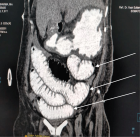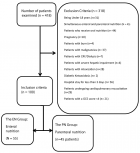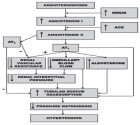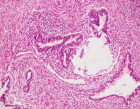Table of Contents
Ectopic Pregnancy Risk Factors Presentation and Management Outcomes
Published on: 29th September, 2023
Background: Ectopic pregnancy (EP) is a common and serious early pregnancy problem with a significant morbidity rate and the potential for maternal death. Women commonly present with minimal vaginal bleeding and abdominal pain.Objective: The main objective of the study was to evaluate the risk factors, clinical presentation, sites, and management outcomes of ectopic pregnancies. Methodology: It was a prospective descriptive, cross-sectional hospital-based study conducted at Bashair Teaching Hospital during the period January 2021–June 2021.An interview questionnaire was used, and eighty-two (82) women were included after informed consent. Demographic and clinical data concerning personal history, symptoms of presentation, risk, site, and type of management were recorded.Results: Ectopic pregnancy incidence was 2% and most risk factors were infection 29.3%, surgery 15.9%, miscarriage 13.4%, infertility 12.2%, tubal surgery 4.9%, previous ectopic pregnancy 4.9%, intrauterine contraceptive device (IUCD) 3.6%, and tubal ligation 2.4%. Women presented with bleeding and abdominal pain at 47.5%, bleeding at 18.3%, abdominal pain at 9.7%, and shock at 8.5%.The sites are ampullary (57.3%), fimbria (9.7%), interstitial (8.5%), isthmus (8.5%), ovarian (7.3%), cervical (4.8%), and abdominal (3.6%).Surgical management was 93.9%, medical and surgical management was 3.6% and medical management was 2.4%. A blood transfusion was received at 37.8%.Conclusion: The study concluded that women of reproductive age are at risk of ectopic pregnancy, so healthcare providers and doctors should have a high index of suspicion, prompt diagnosis, and intervention for ectopic pregnancy. Assessment of women at risk factors and modifications will reduce incidence.
Heart Rate Variability Biofeedback and Psychotherapy in Polycystic Ovary Syndrome: Description of a Case Report to Shed Light on this Understudied Condition
Published on: 20th September, 2023
Background: Although there is minimal information on the role of stress in PCOS, it is well-known that it may trigger the exacerbation and maintenance of the disease. Despite there being only a few studies in the literature, many researchers highlighted situations of autonomic hyperactivation characterizing PCOS. In light of these assumptions, the purpose of this study is to report on a patient who underwent psychological intervention to enhance stress management skills.Case: A 30-year-old woman was referred by the endocrinologist. From a clinical-psychological point of view, the condition of the patient was characterized by a modest psychophysiological activation. Interpersonal difficulties did not allow the patient to benefit from the social support of her loved ones, further favoring the maintenance of the excessive arousal generated by stressful life events. The patient was treated with HRV-Biofeedback integrated within cognitive-behavioral psychotherapy.Discussion: The multidimensional intervention brought benefits to the patient, teaching her better stress management strategies (i.e., reduction of psychological symptoms and improvement of hormonal tests). Keeping in mind the interplay between physiological, psychological, and interpersonal factors is fundamental in all psycho-somatic and somato-psychic disorders and is crucial to enhance the use of specific treatments to restore psychophysical well-being.
High-Grade Endometrial Mesenchymal Sarcoma: Current Status and Future Trends
Published on: 19th September, 2023
Endometrial Stromal Sarcoma (ESS) is a rare gynecological malignancy originating from endometrial stromal tissue. Representing only a tenth of uterine malignant tumors, ESS is categorized into Low-Grade (LGESS) and High-Grade (HGESS) based on nuclear division. Interestingly, prognostic studies have found no strong correlation between ESS prognosis and nuclear division activity. Undifferentiated Uterine Sarcoma (UUS) represents a spectrum of tumors with varied morphological, clinical, and prognostic features, and lacks a standardized naming convention. In 2014, the World Health Organization grouped ESS into LGESS, HGESS, and UUS based on clinical and pathological attributes. HGESS, despite its rarity, is notorious for its poor prognosis and low survival rate. Its early detection is complicated due to its asymptomatic presentation and ambiguous pathogenesis, leading to debates over treatment approaches. This article delves into the recent research developments concerning HGESS.
Impact of Primary Cesarean Section on Grand Multiparous Women
Published on: 11th September, 2023
Background: Grand multiparty is common obstetrical problem, in Sudan large families is desirable for cultural and religious backgrounds and higher incidence of grandmultipra is expected, the risk factors associated with adverse maternal outcomes have yet to be adequately investigated among grand multiparity need to delivered by primary cesarean section.Objective: The main objective was to determine impact of primary cesarean section on grand multiparous, it is indications and complications.Methodology: It was a descriptive prospective cross-sectional hospital-based study conducted at Omdurman Maternity Hospital during period October 2016 to March 2017.An interview questionnaire was used for data collection. Demographic and clinical data concerning personal history, parity, indications of primary cesarean section, type of Cs, maternal complication and neonatal complications were recorded. Also, multiparous less than five delivery, previous lower segment caesarean section, known medical disorders except anemia and twin pregnancy were excluded.Results: During the study period total of 113 grand multipara included, incidence of primary cesarean section in grand multipara was 10%. Indication in our study 22.1% due to malpresentation, fetl distress 15% and prolonged first stage 13.4%, prolonged second stage 12.4% and antepartum haemorrhage 11.5%. Postpartum haemorrhage developed in 9.7%, hysterectomy 1.8%, uterine tear 5.4% bladder injury fetal laceration 3.6%, spinal anesthesia headache 7%, post-partum pyrexia 5.3%, sepsis 4.4%, urinary tract infections were 2.7%.Conclusion: The finding in this study showed 10% incidence of primary cesarean section in grandmultipra. The most indications of primary cesarean section in grandmultipra malpresentation, fetal distress, prolonged first and second stage of labour. Most CS were emergency.
Case Report: Haultain’s Method Reposition for Subacute Uterine Inversion
Published on: 22nd August, 2023
Background: Uterine inversion is a rare obstetric emergency but potentially life-threatening condition. If these are not immediately diagnosed, the massive and underestimated blood loss can lead to hypovolemic shock. Case: Case of 24 years old woman was referred from the district Public Health Center with vaginal bleeding after delivery with abdominal pain. We found fundal height postpartum is 3 fingers above symphysis and confirmed a soft mass protruding inside the vagina at the local examination. The ultrasound cannot present the fundus of the uterus and impressed a uterine inversion. Stabilization for the patient is done with fluid resuscitation and blood transfusion. The patient planned for exploratory laparotomy and we confirmed uterine inversion. We did per abdominal reposition success which was managed by Haultain’s method. Conclusion: Uterine inversion should be considered in any patient with symptoms of hemorrhage and abdominopelvic pain, with the physical findings of a soft, congested, bleeding mass within the vagina on bimanual examination. Prompt treatment consists of fluid resuscitation and anatomical repositioning is needed.
A Comparative Study of Serum Sodium and Potassium Levels across the Three Trimesters of Pregnancy
Published on: 10th August, 2023
Aim: To evaluate the serum sodium and potassium levels in the three trimesters of pregnancy in women. Methods: Four groups of healthy women between the ages of 20 and 30 years, volunteered for this study. Group 1: Non-pregnant women (control), Group 2: Pregnant women in their first trimester, Group 3: Pregnant women in their second trimester, Group 4: Pregnant women in their third trimester. Blood samples were collected by standard aseptic method and serum samples were analyzed for serum levels of sodium and potassium by the ion selective electrode method. Results were presented as MEAN ± SEM in tables and figures, p < 0.05 was regarded as statistically significant. Results: The serum sodium concentrations in mmol/L were 135.3 ± 3.09, 136.3 ± 1.55, 139.0 ± 0.78, 139.8 ± 0.91 for control, first-trimester, second-trimester, and third-trimester subjects respectively. The potassium concentrations in mmol/L were 3.678 ± 0.26, 3.687 ± 0.13,3.820 ± 0.11, 3.767 ± 0.07 for control, first-trimester, second trimester and third-trimester subjects respectively. The Bodyweight values in kg were 72.13 ± 2.11, 74.73 ± 2.05, 75.00 ± 1.72, 81.56 ± 4.24 for control, first-trimest, second-trimester, and third-trimester subjects respectively. Conclusion: Results indicate that the hormones of pregnancy altered the body weight of pregnant women, but did not change the serum sodium and potassium level across the three trimesters of pregnancy in women. This is an indication that the kidneys of healthy pregnant women can handle serum electrolyte load during the period of pregnancy.
Quality of Antenatal Care and its Determinants in the Urban-Rural Environment of Kamina, Democratic Republic of the Congo
Published on: 28th July, 2023
Introduction: Every woman should receive quality antenatal care during pregnancy wherever she lives. We carried out this research with the objective of evaluating the quality of antenatal consultations (ANC) in terms of periodicity, screening, and prophylaxis interventions during antenatal consultations in Kamina and to identify the determinants associated with inadequate ANC. Material and methods: This was a descriptive and analytical cross-sectional study carried out in 6 health facilities in Kamina over a period of 17 months with 476 women who had given birth having attended antenatal consultations at least once. A scoring grid of periodicity standards, screening, and prophylactic interventions with a score of 40 was used to qualify the ANC as adequate. Logistic regression was performed to identify the determinants of inadequate ANC. Results: 40.3% of mothers had reached at least 4 antenatal visits (3.4±1.36); 21.2% had started the ANC no later than 16 weeks for an average age of 22.8 weeks ± 6.19. Overall, 72.5% of pregnant women had benefited from ANC qualified as inadequate. After adjustment, the determinants of inadequate ANC were multigestity (aOR=1.86[1.08-3.19]), low level of education of the mother (aOR=3.93; 95% CI=[2, 08-7.42]), and attendance at a first-level health facility (aOR=3.22; 95% CI=[2.06-5.05]. Conclusion: In the majority of cases, the ANC received by pregnant women in Kamina is inadequate. The determinants thus identified should serve the actors to direct the means to improve the quality of antenatal care in Kamina.
Comparative Analysis of HtrA3 and NGAL as Viable Biomarkers for Pre-eclampsia
Published on: 6th July, 2023
Pre-eclampsia is a pregnancy-associated condition, which is characterized by the onset of hypertension and proteinuria. It is one of the leading causes of maternal and neonatal mortality and this affliction has been recorded in around 8% of all pregnancies in the world. In addition to this, the etiopathology of this condition is very less understood and the resources available to diagnose and treat it are limited. Prior studies suggest more than a hundred possible diagnostic biomarkers that could be used to detect this disease early on. However, most of them are not feasible due to several reasons including stability, cost, safety, etc. Here two biomarkers HtrA3 (high-temperature requirement A3) and NGAL (Neutrophil Gelatinase Associated Lipocalin) are selected for the detection of pre-eclampsia, and we compare their efficacy in the detection of pre-eclampsia based on their specificity, ease of use, speed, stage of detection and source (invasiveness). We found that these two biomarkers are efficient under some parameters, and inefficient under others. The scoring system used in the current study suggests that NGAL is a superior biomarker. The results of this study help to develop a stronger understanding of both these biomarkers in the short and long term to classify the biomarkers more efficiently and understand the complicated pathologies of pre-eclampsia.

If you are already a member of our network and need to keep track of any developments regarding a question you have already submitted, click "take me to my Query."

















































































































































